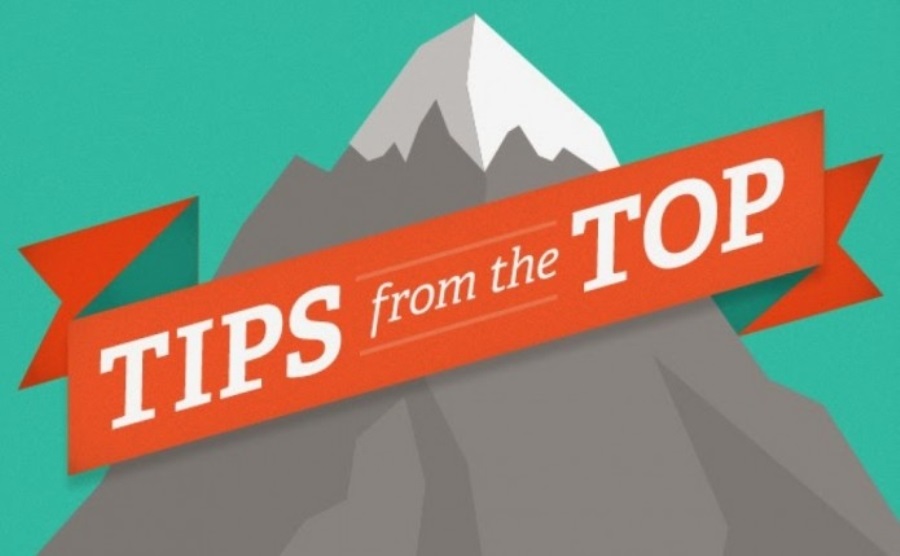Forrester Research gives marketers one advice – Ditch the traditional sales funnel and focus on the customer lifecycle to build stronger customer relations.
Couple this advice with the emerging nonlinear purchase path and the tip becomes inevitable. With purchase journey fragmented into numerous touch-points, marketers have little control over the process.
It is only by understanding the customer lifecycle that marketers can decide better about marketing investments. Their approach should now be customer-centric. Usually, the customer lifecycle is discussed with a misconception that optimizing one metric is enough for handling all customers. What they forget is, that a customer’s journey is spread across various micro-moments and their behavior in those moments comes together to form their unique persona.
So, let us go ahead and hear what some of our marketing experts have to say about the biggest mistakes that marketers have made and how they can be dealt with.
Stage 1 – Reaching Customers
This is the stage of spreading brand awareness which can be done through word-of-mouth, social media, paid ads, referrals, email, etc. With all these options available, marketers need to thoroughly research the various ways which they can use to reach their audience. Failing to excite the audience at this stage may result in failure of the whole campaign.
Mistake #1
 Boris (Baruch) Kogan, Marketing Manager at Bontact states,
Boris (Baruch) Kogan, Marketing Manager at Bontact states,
“From my perspective, the biggest mistake that marketers make when dealing with the customer lifecycle is in the way they think about contact with the customer. They focus just on initiating the contact rather than having a more personalised interaction with them.”
As Boris mentioned above, marketers must deliver value to the target audience in every piece of content. It can educate them, entertain them or do both. The goal is to position your content in a way that it addresses the current/ future needs of the customer even if you’re trying to pitch your product.
What to do about it?
Instead of trying to find customers, let them find you online.
Create valuable, compelling content that’s worth seeking out. This way the customer will feel that he has control over the interaction rather than being marketed to. Word-of-mouth and user-generated content are two ways to do so.
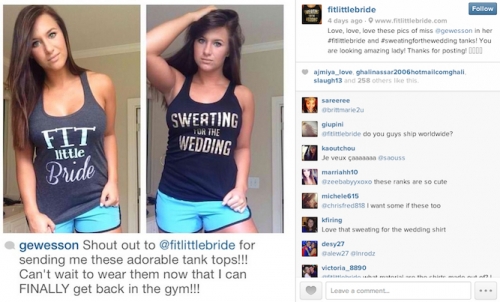
Fit Little Bride, an online store, selling workout clothing for to-be brides and grooms, exploits user-generated content on Instagram. This way the brand builds trust and following, as pictures become the proof of their products being bought, tried and loved. Thus, the content cardinally becomes profitable and compelling without much effort.
Stage 2 – Acquisition
The next stage of the lifecycle is all about acquiring the target audience, and not being interesting or useful at this point may lead to complete abandonment.
Mistake #2
 Bjarne Viken, Conversion Strategist at ScaleUp states,
Bjarne Viken, Conversion Strategist at ScaleUp states,
“I regularly review websites, and the biggest mistakes I see is that their homepage fails to make a clear argument for why a customer should act. Little or any evidence, unclear value proposition, and difficulty to identify the first line action takes away all the joy and interest.”
Mistake #3
 Marc Prosser, co-founder of Fit Small Business and Fit Biz Loans further adds –
Marc Prosser, co-founder of Fit Small Business and Fit Biz Loans further adds –
“Customers are highly sensitive to pricing and that is another mistake made most times. This factor actually makes an ecommerce store vulnerable at any stage of the customer lifecycle. If you raise your prices, customers are likely to flee your business. It’s important to understand that price is a big factor for your customers, so you can plan accordingly to keep the life cycle from getting cut short by another business.”

As seen here, there are no deals, offers, propositions or call-to-action for the customer which can initiate the first line of action. There is actually no proposed path that the customer can take to explore the website and purchase something.
What to do about it?
Make your homepage which is the face of your brand, as unique, interesting, and useful for the customer so much so that it compels him to take the next step in the lifecycle. Identify what differentiates you from everyone and for that ask yourself, “What am I offering to the audience that others are not?”
Create a solid argument for why someone should do business with you. Do you offer more discounts or are your offers and deals just irresistible? Whatever it is, your homepage should reflect it. Back up your argument with evidence. Customer reviews can speak a ton for your brand. Always remember, existing customers delighted with your services are bound to bring in new leads.
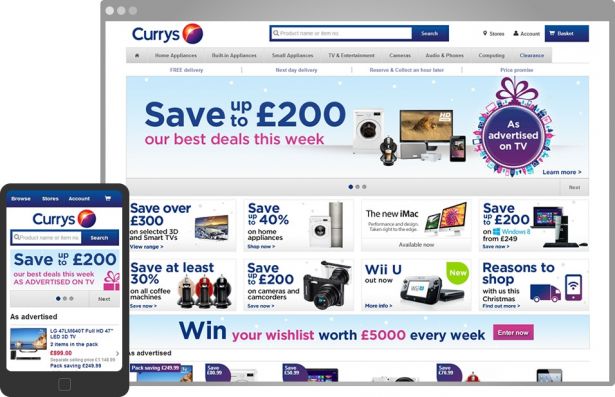
Currys has ensured to mention every one of its deals and offers on the homepage which is a good strategy to get the customer to explore the website further.
Stage 3 – Conversion
Whenever a visitor visits a website, and your desired action, is completed by them, that is when a conversion happens. Your desired action for the visitor might be wanting them to sign up for a free account, become a member of your mailing list, or making a purchase. Since your ability to achieve your business goals depends on conversions. However, like all other stages, here too we have the danger of attrition.
Mistake #4
 According to Hunter Leonard, Founder/ CEO, Blue Frog Marketing–
According to Hunter Leonard, Founder/ CEO, Blue Frog Marketing–
“The biggest mistake marketers make with existing customers is to not survey them often enough for current needs and wants and limiting communication.”
Attrition during conversion can happen due to any reason, some way beyond the business’ control. Looking at controllable attrition factors, one great mistake is insufficient research and analysis of its existing customers.
Just think about how it would feel if you went to a store to purchase a pair of shoes and they try selling you a book instead?
What to do about it?
Know your customer and know them well. Look into their purchase history, ask for opinions, or hold surveys that will help you understand their preferences. Businesses should focus more on the overall customer experience, on page as well as the whole journey from PPC click to landing page, to product page, and finally to the cart and more.
Be inquisitive about the entire purchase journey and ask what happens afterwards, what the types of retargeting ads are, and how to have better reminder emails. All these pieces brought in together to complete a jigsaw puzzle will show us a bigger picture that can both be personal & rewarding.
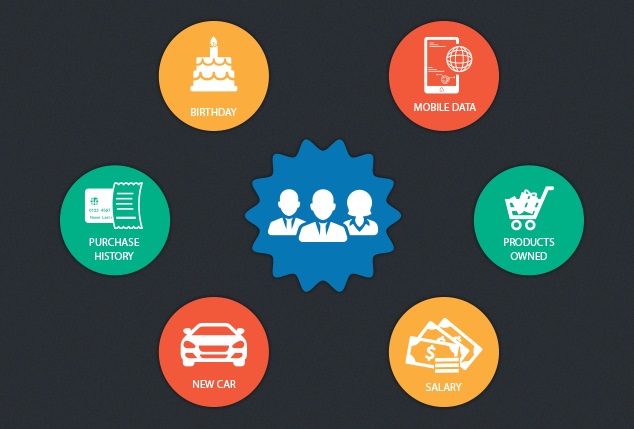
Mistake #5
 Matthew Ehrman, Senior Copywriter/Social Media Manager at BeCreative360 says,
Matthew Ehrman, Senior Copywriter/Social Media Manager at BeCreative360 says,
“Businesses that maintain an email list should use it to keep their customers apprised of any kind of promotional offers and changes in their business. One needs to know their customers and stay in enough contact so as to remain in the customer’s mind, but not so much so as to aggravate the customer and portray a brand negatively.”
What to do?
Marketers should send customers emails and notifications based on their search history and purchase behavior. The email should identify the specific product and remind the customer that it is in their cart. Marketers can track the mail sent to customers and if they do not open the first email then a follow-up email can be sent again as reminder.
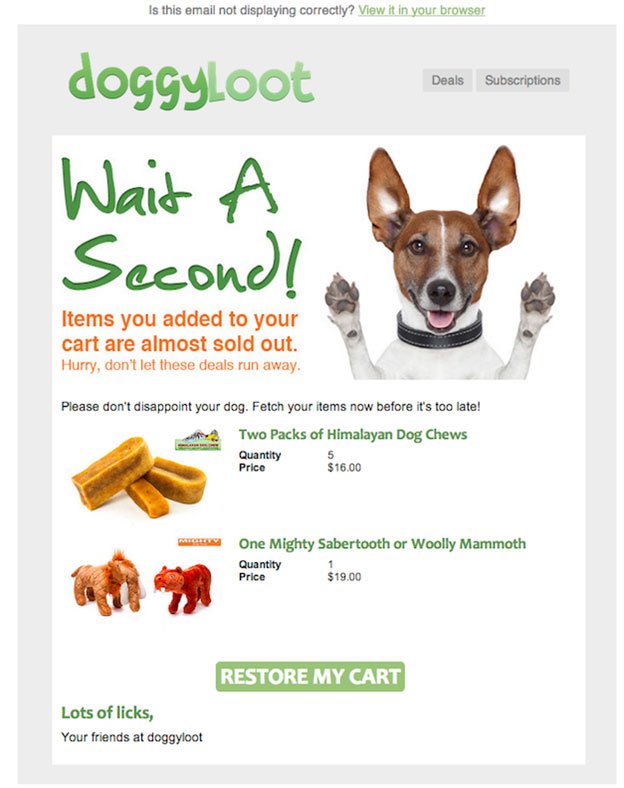
Doggyloot uses the “almost sold out” strategy along with the abandoned cart reminder which is both catchy and attractive to the potential customer.
Stage 4 – Retention
Customer retention strategies allow marketers to obtain more value out of the existing customers. This is the level when marketers should defend their customers from competitors through various loyalty programs and schemes.
Mistake #6
 Amanda Smith, Client Services Associate at Chelsea Technologies states,
Amanda Smith, Client Services Associate at Chelsea Technologies states,
“There are numerous obvious factors that lead to client retention. We can effortlessly make a list as follows- building rapport and trust, providing excellent customer service, and creating open and honest communication between your company and your client. These are just a few examples which can happen easily even when everything is running smoothly. But, it’s the time when the business relationship is not at its best when marketers can use the situation to your advantage.”
As Amanda explains, not being able to give customers solutions to their problems when they really need us is one of the reasons why they choose to leave us. At such times, the customer feels neglected and aloof, especially when they keep getting passed on from one end to another.
What to do about it?
Turn difficult situations into opportunities to earn your customer’s trust in the long run. It a great time to reflect your loyalty towards working with an upset customer to remediate the situation.
This is the time when customers should be followed up, if possible met in person, provide them with details as your company is working through the dispute, and listen to them as they voice their opinions. You can even take the help of Customer Satisfaction Surveys to gauge whether a client is silently dissatisfied with your service.
Be proactive in the types of services you provide and refrain difficult situations in the future. It only increases customers trust when you both make it through a difficult situation together.
Mistake #7
Matthew Ehrmann in addition again states here, “The biggest mistake a marketer can make in regards to customer retention and life cycle is not finding that sweet spot between having no contact with a customer and having too much contact. Either one of these extremes results in a poorly nurtured customer, and thus, a shorter life.”
What to do about it?
Send only relevant notifications at a relevant time and do not over do it. You can do this via mobile notifications or email.
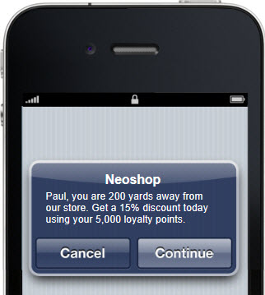
This notification from the Neo Shop comes at the right time just when the customer is 200 yards away from the store. Furthermore, they are offering 15% discount if the customer chooses to visit and buy anything on the same day.
Stage 5 – Loyalty
At this stage, the customer looks at you like an acquaintance or a friend and becomes a loyal advocate of your business recommending it to everyone. However, not all your customers are able to reach this stage and that is why marketers should try to acquire a few more with every product cycle.
Mistake #8
 According to Mike Wood, online marketer and owner of Legalmorning.com,
According to Mike Wood, online marketer and owner of Legalmorning.com,
“One of the biggest mistakes that a marketer can make during the lifecycle is failing to stay in touch or failing to make personal content. It is great that you have an email list but you also need to reach out and let people know you are there on a personal level.”
Marketers make a huge mistake by not realizing that a particular customer has reached this stage. A loyal customer must be treated with some additional importance that differentiates him from the usual one-time customers, thus, awarding him for his loyalty.
What to do about it?
Keep track of your loyal customers and give them special attention. Use the approach of reciprocal loyalty towards your customers and increase their devotion towards your brand. Thank your loyal customers even before they have made a purchase from your brand.

The image illustrates the exclusive discount given by Banana Republic to its customer as a reward for their loyalty.
 Jeff Epstein, Founder & CEO, Ambassador states
Jeff Epstein, Founder & CEO, Ambassador states
“Marketers are not taking advantage of the post-conversion stage of a customer and leveraging referrals. By turning customers into brand ambassadors, companies can leverage positive word-of-mouth to drive revenue and bring in new loyal customers with longer lifetime value.”
Conclusion
It is crucial to manage customer lifecycle in today’s competitive marketplace. Predictions are that, within the coming five years, the customer lifecycle will prompt organizations to internally disrupt themselves to do things like creation of new customer touch-points through web-enabled “smart” products.
It is also expected that usual marketing teams will be replaced by customer lifecycle marketers who would address customers comprehensively. Consumers, unlike now, will manage their own data, thus necessitating companies to be extremely relevant and targeted in the way they interact with their customers.
A better understanding of the customer lifecycle is the key for continued success. If your company implements the perfect customer lifecycle management, you can improve your customer service and enhance your customer’s experience. This will finally result in an increase in the usage of the business’ products or services with improved profit margins.
Download an interesting research on what works (and what doesn’t) in email marketing for ecommerce by TargetingMantra.



